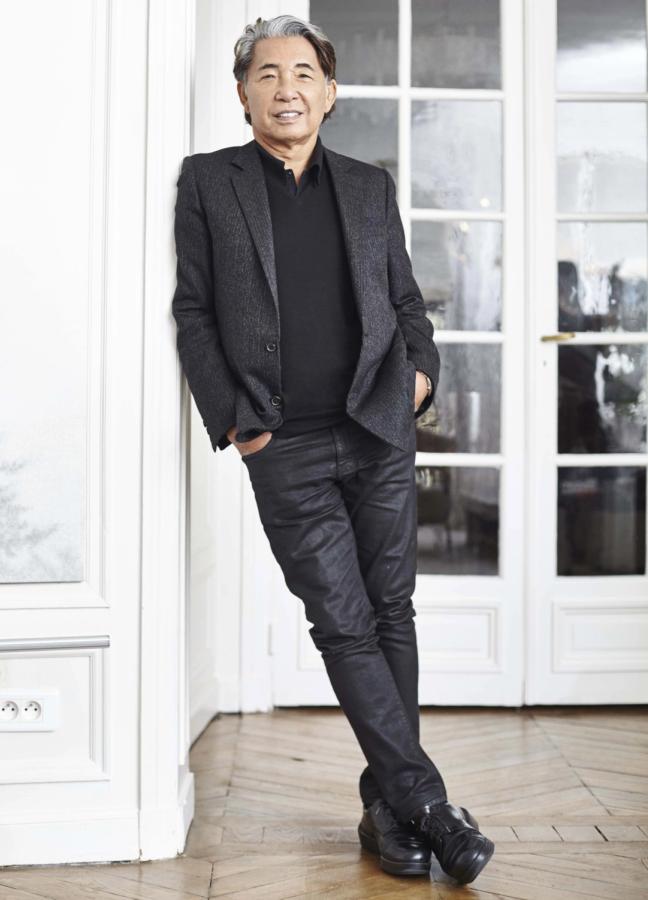When Kenzō Takada first visited Paris in 1964, he thought he’d be there for just a few months. One of the first male students to attend fashion college in his native Japan, Takada was told that the French fashion world wasn’t the most welcoming place for arriviste would-be designers.
In the end, however, Takada stayed in Paris and in fashion for many years, while the brand that bears his name swiftly became a pillar of global style. Along the way he defined a more colourful, pattern-rich design trend; drove the first designer and high-street collaborations; and paved the way for the success of other Japanese designers in the west, such as Issey Miyake and Junya Watanabe.
Takada sold his business to the LVMH Group in 1993 for $80m, and then retired. He expected to go on “holiday for ever” as he puts it, but his intentions were confounded — over the two decades since, the 80-year-old has been drawn back to design fragrances, furniture and objets d’art. “I have to have a creative outlet,” he says. “I sketch, I paint. I did try to play the piano. At least, I tried a few times…”

Kenzō Takada
Men weren’t accepted in the fashion world [in Japan] when I applied for the Bunka Fashion College in Tokyo and there were no jobs. In fact, there wasn’t much in the way of ready-to-wear for men. Now I look back, applying for a place felt brave. My father was against the idea, but my mother knew how much I loved to draw — and that’s why I started out as an illustrator. By the second year of the course we had to pick options. Most were technical, and I hated the technical aspect, so I chose fashion design instead.
I never really hoped to work in fashion in Paris because I kept being told that it would be impossible for a Japanese person to do so. At the time, Japan had the same image that, say, China had 10 years ago — and that wasn’t a good image. There was this sense that nobody from Japan could be competent [in this field]. It was really a dream for me to go there. There was the Nouvelle Vague and Paris was in all the films I watched. It was 60 years ago but I still remember arriving at the Gare du Nord and thinking: “My God, I’ve made a big mistake here”. Everything was so dark and dirty. It was only when I got to see Notre Dame illuminated that I changed my mind.
When I started out I didn’t have much money, so I mixed affordable classic textiles from Japan with pieces I found in the Paris flea markets. I didn’t have the right contacts to get anything else anyway, but it still ended up having a big impact. I think it was because I was looking for some kind of identity as an outsider, so I wanted to bring something very Japanese into it, and that meant textiles with a lot of colour and pattern. That ended up helping me define a style for myself.
If I made one major contribution to fashion it was helping to bring some accessibility to it. What I did wasn’t exactly basic but it wasn’t couture either, and this was at a time when French fashion was all about couture. It created a new market in a way. At the time you don’t realise that what you’re doing might be in some way new, because everything is moving so fast. I consider myself very lucky though because it was exactly the right time for what I happened to do.
When you’re designing clothes for people to wear you actually have to think practically. How will the garment fit? How will it wear? Designing costume for opera [in contrast] is all about visual impact, but that’s interesting in its own right — does it fit in with the set decoration? What’s it like to move in? It’s been good to get back into designing clothing. But the pace is much slower when you’re designing some furniture. That’s how I like it now. You’re not having to think about ‘the season’ all the time. Fashion is highly democratic these days, which is great, but it also makes the industry intensely competitive.
It’s strange, but as I’ve grown older I find that I’m wearing more and more monochrome. Sometimes there’s a touch more colour in the summer, but essentially I’m all black and grey and I don’t know why. Maybe it’s that unspoken rule that Japanese designers all have to wear black.
I love sketching — when it works. Some days it just doesn’t come. When you sketch there’s a really physical aspect to the process, of course, and it’s where the ideas are generated, but it’s also the start of the process of seeing lines on a piece of paper manifested in actual clothing. And that’s the greatest feeling — seeing someone in the street wearing something that started out as your sketch.
Kenzō Takada by Kazuko Masui and Chichiro Masui is published by ACC Art Books, £35.75

Become a Gentleman’s Journal Member?
Like the Gentleman’s Journal? Why not join the Clubhouse, a special kind of private club where members receive offers and experiences from hand-picked, premium brands. You will also receive invites to exclusive events, the quarterly print magazine delivered directly to your door and your own membership card.


